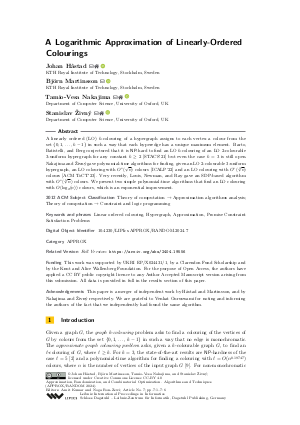@InProceedings{hastad_et_al:LIPIcs.APPROX/RANDOM.2024.7,
author = {H\r{a}stad, Johan and Martinsson, Bj\"{o}rn and Nakajima, Tamio-Vesa and \v{Z}ivn\'{y}, Stanislav},
title = {{A Logarithmic Approximation of Linearly-Ordered Colourings}},
booktitle = {Approximation, Randomization, and Combinatorial Optimization. Algorithms and Techniques (APPROX/RANDOM 2024)},
pages = {7:1--7:6},
series = {Leibniz International Proceedings in Informatics (LIPIcs)},
ISBN = {978-3-95977-348-5},
ISSN = {1868-8969},
year = {2024},
volume = {317},
editor = {Kumar, Amit and Ron-Zewi, Noga},
publisher = {Schloss Dagstuhl -- Leibniz-Zentrum f{\"u}r Informatik},
address = {Dagstuhl, Germany},
URL = {https://drops.dagstuhl.de/entities/document/10.4230/LIPIcs.APPROX/RANDOM.2024.7},
URN = {urn:nbn:de:0030-drops-210006},
doi = {10.4230/LIPIcs.APPROX/RANDOM.2024.7},
annote = {Keywords: Linear ordered colouring, Hypergraph, Approximation, Promise Constraint Satisfaction Problems}
}

 Creative Commons Attribution 4.0 International license
Creative Commons Attribution 4.0 International license
